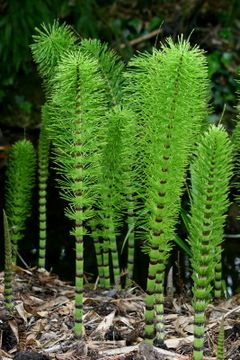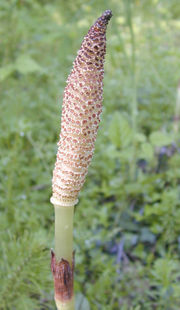ذنب الحصان
| Equisetaceae | |
|---|---|

| |
| "Candocks" of the Great Horsetail (Equisetum telmateia telmateia), showing whorls of branches and the tiny dark-tipped leaves | |
| التصنيف العلمي | |
| مملكة: | |
| Division: | |
| Class: | |
| Order: | |
| Family: | Equisetaceae
|
| Genera | |
|
Equisetum | |

The small white protuberances are accumulated silicates on cells.
ذَنَب الحصان Horsetail نبات مفصلي، مجوَّف، تحتوي ساقه على السليكا، وهي مادة كاشطة. يُطلق على ذَنَب الحصان أيضًا أسل الكشط ذيل الحصان، لأنه كان قديمًا يُستعمل لكشط المعادن. ولنبات ذنب الحصان قدر من الخواص العلاجية. تكون معظم نباتات ذنب الحصان صغيرة. تشابه سيقان بعض أنواعه أشجارًا دقيقة. في أزمنة ما قبل التاريخ، كانت بعض نباتات هذه العائلة تنمو لتكون أشجارًا كبيرة. ينمو النبات من جذور زاحفة تدوم طوال السنة. وهي لا تحمل زهرات وتكون أقرب إلى السراخس منها إلى النباتات الزهرية. يتكاثر ذنب الحصان بوساطة كل من الأبواغ وخلايا الجنس. تكون الأبواغ داخل كيزان صغيرة على أطراف الساق أو فروعها، أو تكون في بعض الأحيان داخل ساق منفصلة. يطلق النبات الأبواغ، التي تنبت في الأماكن الرطبة، وتنمو لتكون نباتات دقيقة. تنتج هذه النباتات خلايا الجنس المذكرة والمؤنثة التي تتحد معًا لتكون نباتات ذنب الحصان المكتملة النمو.

المصادر
انظر أيضا
حواشي
مراجع
- Husby, Chad E. (2003): How large are the giant horsetails? Version of 2003-MAR-19. Retrieved 2008-NOV-20.
- Israelsen, Clark E.; McKendrick, Scott S. & Bagley, Clell V. (2006): Poisonous Plants and Equine. PDF fulltext
- Pigott, Anthony (2001): National Collection of Equisetum - Summary of Equisetum Taxonomy. Version of 2001-OCT-04. Retrieved 2008-NOV-20.
- Pryer, K.M.; Schuettpelz, E.; Wolf, P.G.; Schneider, H.; Smith, A.R. & Cranfill, R. (2004): Phylogeny and evolution of ferns (monilophytes) with a focus on the early leptosporangiate divergences. Am. J. Bot. 91(10): 1582-1598. PDF fulltext
- Rutishauser, Rolf (1999): Polymerous Leaf Whorls in Vascular Plants: Developmental Morphology and Fuzziness of Organ Identities. International Journal of Plant Sciences 160(Supplement 6): 81–103. DOI:10.1086/314221 PDF fulltext
- Smith, Alan R.; Pryer, Kathleen M.; Schuettpelz, Eric; Korall, Petra; Schneider, Harald & Wolf, Paul G. (2006): A classification for extant ferns. Taxon 55(3): 705-731. DOI:10.1086/314221 PDF fulltext
- Weber, Reinhard (2005): Equisetites aequecaliginosus sp. nov., ein Riesenschachtelhalm aus der spättriassischen Formation Santa Clara, Sonora, Mexiko [Equisetites aequecaliginosus sp. nov., a tall horsetail from the Late Triassic Santa Clara Formation, Sonora, Mexico]. Revue de Paléobiologie 24(1): 331-364 [German with English abstract]. PDf fulltext
وصلات خارجية
| Equisetaceae
]].- The Wonderful World of Equisetum
- HDRA Organic Weed Management: Field horsetail - includes Occurrence, Biology, Persistence and Spread, Management and Discussion
- Equisetum hyemale L., scouringrush horsetail
- National Collection of Equisetum
